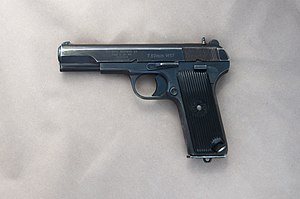Zastava M57
| Zastava M57 | |
|---|---|
 The M57 with a loaded 9-round magazine. | |
| Type | Semi-automatic pistol |
| Place of origin | Yugoslavia |
| Service history | |
| In service | 1961–1992 (Yugoslavia) |
| Used by | Yugoslav People's Army |
| Wars | Vietnam War Persian Gulf War Internal resistance to apartheid[1] Yugoslav Wars Russian invasion of Ukraine[2] |
| Production history | |
| Designer | Zastava Arms |
| Designed | 1957[3] |
| Manufacturer | Zastava Arms |
| Produced | 1963–1982[4] |
| No. built | 260,000–270,000[4] |
| Variants | See Variants |
| Specifications | |
| Mass | 854 g (30.1 oz) |
| Length | 194 mm (7.6 in) |
| Barrel length | 116 mm (4.6 in) |
| Height | 134 mm (5.3 in) |
| Cartridge | 7.62×25mm Tokarev |
| Action | Short recoil actuated, locked breech, single action |
| Muzzle velocity | 480 m/s (1,575 ft/s) |
| Effective firing range | 50 m |
| Feed system | 9-round detachable box magazine |
| Sights | Front blade, rear notch 156 mm (6.1 in) sight radius |
The Zastava M57 is a Yugoslavian and Serbian semi-automatic pistol produced by Zastava Arms. It was the standard service pistol of the Yugoslav People's Army from 1961 until the early 1990s.[3] The M57 was an unlicensed derivative of the Soviet TT pistol, with a number of modifications, namely a longer grip and a slightly larger magazine.[2] Zastava reverse engineered the Soviet TT in 1954, and began serial production of the weapon type as the M57 in 1963.[3]
As of 2021, Zastava still produced modernized variants of the M57 with updated safety features - the M57A in its original chambering and the M70A in 9mm Parabellum.[5]
History
[edit]Designed in the mid-1950s, the M57 was an unlicensed copy of the Soviet TT-33 Tokarev.[3] The Yugoslav People's Army had initially attempted to adopt the TT as its standard service pistol after World War II, and a number were delivered by the Soviet Union.[3] However, the Tito–Stalin split prompted the Soviet government to cease military aid to Yugoslavia before deliveries of the pistol were fully completed.[3] In 1952, Zastava was charged with developing its own variant of the TT to satisfy the army's needs.[4] Zastava's engineers were able to reverse engineer the weapon by 1954, creating a faithful copy of the original TT.[3] However, its factory was already at capacity manufacturing rifles and submachine guns, and it was unable to open a new production line to produce a new handgun.[4] The project was shelved until 1956, when army officials again expressed interest in the TT design.[3] Work on an improved TT derivative began in earnest in 1957, and the first prototypes appeared in 1960.[3] The Zastava pistol was formally designated M57 and accepted for service in 1961.[3] Although the army took delivery of various pre-production models that year, serial production was delayed until 1963.[3]
Zastava manufactured the M57 for the Yugoslavian state from 1963 until 1982, at which time at least 260,000 had been produced.[4] It was retired from military service in the former Yugoslavia during the late 1990s and early 2000s, being largely superseded by the Zastava CZ99.[3]
Design details
[edit]In 1954, Zastava initially unveiled a handgun that was an identical copy of the original TT-33.[4] However, between 1957 and 1960, a number of modifications to the Soviet design were made.[3] The most noticeable difference is that the M57 was designed with a larger magazine that has a capacity of nine rounds as opposed to the TT-33's eight.[4] The M57 was also fitted with a magazine safety, reducing the likelihood of an accidental discharge while the magazine is being removed.[4] Zastava engineers added a dovetailed front sight that may be adjusted for windage, and the top of the weapon's slide is serrated to reduce glare.[4] There were a few minor internal changes as well, including a unique Zastava firing pin and a captive recoil spring to simplify disassembly.[4]
Variants
[edit]- M57: Standard military version.[5]
- M57A: Commercial production model of the M57, with an added external slide safety.[5]
- M70A: Export variant of the M57 chambered for 9×19mm Parabellum and introduced in 1970.[5]
- M70AA: Commercial production model of the M70A, with an added external slide safety.[5]
Users
[edit]Former users
[edit] Inkatha Freedom Party[1]
Inkatha Freedom Party[1] North Macedonia: Issued both the M57 and M70A concurrently as standard service pistols.[6]
North Macedonia: Issued both the M57 and M70A concurrently as standard service pistols.[6] Serbia: Retired in the 2000s.[3]
Serbia: Retired in the 2000s.[3] Yugoslavia[3]
Yugoslavia[3]
See also
[edit]Notes and references
[edit]- ^ a b Luthuli, Daluxolo; Bopela, Thula (2005). Umkhonto We Siswe: Fighting for a Divided People. Alberton: Galago Publishing Company. pp. 60, 113. ISBN 978-1919854168.
- ^ a b c "Vintage Weapons In a Modern War: The TT-33 Pistol In Ukraine". The Armourer's Bench. Beaverton. 26 March 2023. Archived from the original on 19 October 2023. Retrieved 16 December 2023.
- ^ a b c d e f g h i j k l m n o Sof, Eric (7 January 2023). "Zastava M57: The Yugoslavian-Made Clone of the Legendary Soviet TT-33 Pistol". Spec Ops Magazine. Dover. Archived from the original on 5 February 2023. Retrieved 16 December 2023.
- ^ a b c d e f g h i j k Thompson, Leroy (2022). Soviet Pistols: Tokarev, Makarov, Stechkin and others. Oxford: Osprey Publishing. pp. 65–67. ISBN 978-1472853486.
- ^ a b c d e Borisenko, Adam (28 May 2021). "Zastava M57 and M70A: The Yugoslavian Tokarevs". The Gun Digest. Appleton, Wisconsin. Archived from the original on 31 May 2023. Retrieved 14 May 2024.
- ^ "Macedonia's Weaponry: A New Nation Re-Arms and Fights". Small Arms Review. Henderson, Nevada. 1 October 2003. Archived from the original on 26 February 2024. Retrieved 14 August 2023.
